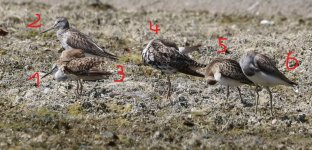jbpixels
Well-known member
Three greenshanks are clear. The ruffs are not so clear to me. Would you please ID support me with the birds 3, 4 and 5. Sex and relevant plumage details would be very helpful to me.
I would like to understand their together. Forget the video bomber at the end.
Thank you for your support.
I would like to understand their together. Forget the video bomber at the end.
Thank you for your support.





